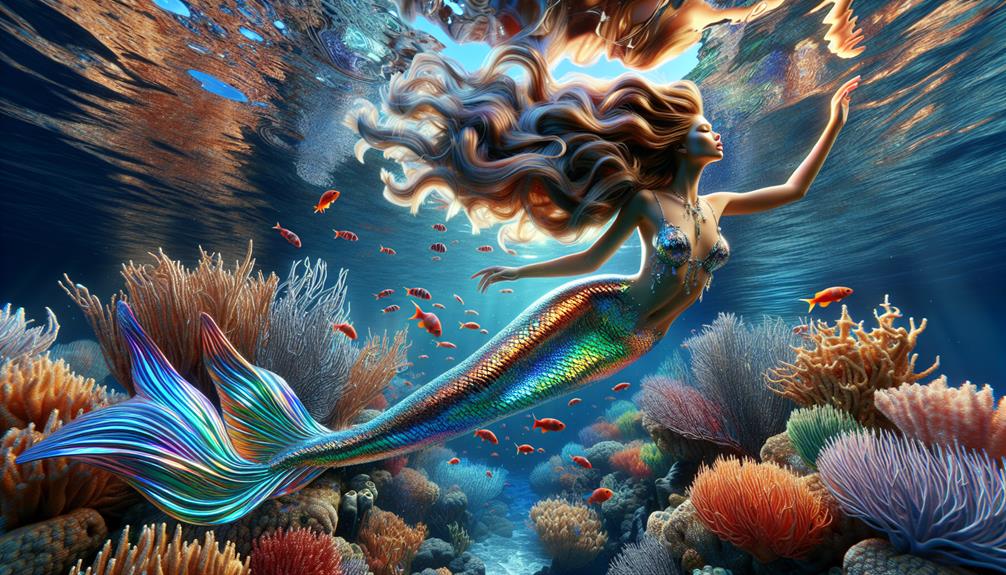You may be surprised to learn that there are historical accounts of mermaid sightings dating back centuries, from various cultures around the world.
These stories often describe encounters with half-human, half-fish creatures, sparking curiosity and debate about the possibility of mermaids existing in real life.
As you consider the evidence and perspectives on this intriguing topic, it becomes clear that there is more to the mermaid lore than meets the eye.
Historical Accounts of Mermaid Sightings
Throughout history, sailors and explorers have reported encountering mysterious, half-human, half-fish creatures, often referred to as mermaids. The historical sightings of mermaids are deeply rooted in folklore legends, and the accounts of these mythical beings have transcended cultures and time periods.
Historical sightings of mermaids date back to ancient times and aren't confined to a specific region. The first recorded mermaid sighting is said to have occurred in 1000 BC by the Assyrians. Tales of these aquatic beings are also present in Greek mythology, with stories of sirens luring sailors to their demise with their enchanting voices. In the 1600s, explorer Henry Hudson and his crew reported seeing a mermaid off the coast of Greenland, adding to the extensive list of historical encounters.
Folklore legends from various cultures have contributed to the perpetuation of mermaid sightings. In Japan, the legend of Ningyo, a fish-like creature with a human face, has been passed down through generations. Similarly, the belief in mermaids is prevalent in the folklore of West Africa, where they're regarded as powerful and alluring spirits of the sea.
These historical accounts of mermaid sightings have sparked curiosity and fascination for centuries, giving rise to ongoing efforts to unravel the mysteries behind these mythical creatures. While modern science attributes these sightings to misidentifications of manatees, dugongs, or other marine animals, the allure of mermaids continues to captivate the human imagination.
Modern Evidence and Scientific Perspectives
The historical accounts of mermaid sightings have led to a contemporary examination of evidence and scientific perspectives regarding the existence of mermaids. Scientific research and analysis of eyewitness testimonies have shed light on the plausibility of these mythical creatures.
Here are some key points to consider:
- Genetic Analysis: Modern scientific techniques have allowed for the analysis of purported mermaid DNA samples. However, no credible evidence has been found to support the existence of a mermaid species.
- Aquatic Mammal Behavior: Some eyewitness testimonies describe mermaids as having human-like features, yet behaving like aquatic mammals. Marine biologists have studied this behavior, but no conclusive evidence of such a species has been found.
- Underwater Acoustic Recordings: Marine research vessels have conducted extensive underwater acoustic recordings to detect any potential mermaid vocalizations. After thorough analysis, no anomalous or unexplained sounds resembling mermaid communication have been identified.
- Cognitive Psychology Studies: Researchers have delved into the study of cognitive biases and the impact of folklore and popular culture on eyewitness accounts. These studies have shown that many mermaid sightings can be attributed to misidentifications, optical illusions, or cultural influences.
Frequently Asked Questions
Can Mermaids Communicate With Other Underwater Creatures?
Underwater communication between marine life is a complex and diverse phenomenon. Many oceanic creatures, such as dolphins and whales, are known to engage in interspecies communication with various other underwater creatures. This often involves a combination of vocalizations and body language.
While there's no scientific evidence to support the existence of mermaids, the concept of them communicating with underwater creatures is purely fictional and not grounded in reality.
Are There Any Known Mermaid Communities or Societies?
While mermaid communities and societies are popular in folklore traditions, there's no scientific evidence supporting their existence.
However, the concept of mermaid culture has captivated human imagination for centuries, inspiring art, literature, and even marine conservation efforts.
Just like the lore of mermaids, these stories and traditions continue to thrive, reminding us of the enduring power of mythical creatures in our collective consciousness.
Do Mermaids Have Any Special Powers or Abilities?
Mythical creatures, such as mermaids in folklore, are often depicted as having supernatural powers and abilities. One common attribute associated with mermaids is their telepathic abilities, allowing them to communicate with other beings using their minds.
In various stories and legends, mermaids are believed to possess the power to influence the thoughts and emotions of humans and other creatures. This portrayal of mermaids in folklore highlights their mystical and mysterious nature.
Are There Any Documented Cases of Mermaids Interacting With Humans in Modern Times?
Yes, there have been documented cases of mermaids sightings throughout history. Aquatic legends and folk tales from various cultures describe encounters with these mythical creatures.
While these accounts are often attributed to folklore and superstition, some believe they could be based on real encounters with unknown underwater creatures.
As ocean mysteries continue to captivate our imagination, the possibility of mermaids or other supernatural beings interacting with humans remains an intriguing topic.
What Do Mermaids Eat and How Do They Find Their Food in the Ocean?
In ocean habitats, marine creatures typically find their food through underwater foraging and aquatic hunting techniques. Their marine diet consists of various organisms such as fish, crustaceans, and algae.
These creatures have adapted to their environment, using their unique senses and physical abilities to locate and capture their prey. It's fascinating to observe how different species have evolved to survive and thrive in the challenging underwater world.
Conclusion
In conclusion, while historical accounts of mermaid sightings may seem compelling, modern evidence and scientific perspectives point to the likelihood of misidentifications or hoaxes.
The lack of concrete evidence, coupled with our understanding of marine biology, suggests that mermaids are more likely to be a product of folklore and imagination rather than real-life creatures.
It's important to approach these claims with a critical and rational mindset in order to separate fact from fiction.

